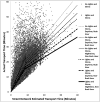Predicting ambulance time of arrival to the emergency department using global positioning system and Google maps
- PMID: 23865736
- PMCID: PMC4288957
- DOI: 10.3109/10903127.2013.811562
Predicting ambulance time of arrival to the emergency department using global positioning system and Google maps
Abstract
Objective: To derive and validate a model that accurately predicts ambulance arrival time that could be implemented as a Google Maps web application.
Methods: This was a retrospective study of all scene transports in Multnomah County, Oregon, from January 1 through December 31, 2008. Scene and destination hospital addresses were converted to coordinates. ArcGIS Network Analyst was used to estimate transport times based on street network speed limits. We then created a linear regression model to improve the accuracy of these street network estimates using weather, patient characteristics, use of lights and sirens, daylight, and rush-hour intervals. The model was derived from a 50% sample and validated on the remainder. Significance of the covariates was determined by p < 0.05 for a t-test of the model coefficients. Accuracy was quantified by the proportion of estimates that were within 5 minutes of the actual transport times recorded by computer-aided dispatch. We then built a Google Maps-based web application to demonstrate application in real-world EMS operations.
Results: There were 48,308 included transports. Street network estimates of transport time were accurate within 5 minutes of actual transport time less than 16% of the time. Actual transport times were longer during daylight and rush-hour intervals and shorter with use of lights and sirens. Age under 18 years, gender, wet weather, and trauma system entry were not significant predictors of transport time. Our model predicted arrival time within 5 minutes 73% of the time. For lights and sirens transports, accuracy was within 5 minutes 77% of the time. Accuracy was identical in the validation dataset. Lights and sirens saved an average of 3.1 minutes for transports under 8.8 minutes, and 5.3 minutes for longer transports.
Conclusions: An estimate of transport time based only on a street network significantly underestimated transport times. A simple model incorporating few variables can predict ambulance time of arrival to the emergency department with good accuracy. This model could be linked to global positioning system data and an automated Google Maps web application to optimize emergency department resource use. Use of lights and sirens had a significant effect on transport times.
Conflict of interest statement
The authors report no conflicts of interest. The authors alone are responsible for the content and writing of the paper.
Figures




Similar articles
-
Effect of urgency level on prehospital emergency transport times: a natural experiment.Intern Emerg Med. 2024 Mar;19(2):445-453. doi: 10.1007/s11739-023-03501-7. Epub 2023 Dec 20. Intern Emerg Med. 2024. PMID: 38123903 Free PMC article.
-
Is Use of Warning Lights and Sirens Associated With Increased Risk of Ambulance Crashes? A Contemporary Analysis Using National EMS Information System (NEMSIS) Data.Ann Emerg Med. 2019 Jul;74(1):101-109. doi: 10.1016/j.annemergmed.2018.09.032. Epub 2019 Jan 12. Ann Emerg Med. 2019. PMID: 30648537
-
The association between ambulance hospital turnaround times and patient acuity, destination hospital, and time of day.Prehosp Emerg Care. 2011 Jul-Sep;15(3):366-70. doi: 10.3109/10903127.2011.561412. Epub 2011 Apr 11. Prehosp Emerg Care. 2011. PMID: 21480775
-
The Critical Intervention Screen: A Novel Tool to Determine the Use of Lights and Sirens during the Transport of Trauma Patients.Prehosp Emerg Care. 2022 Jul-Aug;26(4):566-572. doi: 10.1080/10903127.2021.1961040. Epub 2021 Aug 17. Prehosp Emerg Care. 2022. PMID: 34313543
-
The Use of Emergency Lights and Sirens by Ambulances and Their Effect on Patient Outcomes and Public Safety: A Comprehensive Review of the Literature.Prehosp Disaster Med. 2017 Apr;32(2):209-216. doi: 10.1017/S1049023X16001503. Epub 2017 Jan 30. Prehosp Disaster Med. 2017. PMID: 28134063 Review.
Cited by
-
Current patterns of trauma center proliferation have not led to proportionate improvements in access to care or mortality after injury: An ecologic study.J Trauma Acute Care Surg. 2023 Jun 1;94(6):755-764. doi: 10.1097/TA.0000000000003940. Epub 2023 Mar 7. J Trauma Acute Care Surg. 2023. PMID: 36880704 Free PMC article.
-
Travel Time to Hospital for Childbirth: Comparing Calculated Versus Reported Travel Times in France.Matern Child Health J. 2018 Jan;22(1):101-110. doi: 10.1007/s10995-017-2359-z. Matern Child Health J. 2018. PMID: 28780684
-
Effect of urgency level on prehospital emergency transport times: a natural experiment.Intern Emerg Med. 2024 Mar;19(2):445-453. doi: 10.1007/s11739-023-03501-7. Epub 2023 Dec 20. Intern Emerg Med. 2024. PMID: 38123903 Free PMC article.
-
Accuracy of Perceived Estimated Travel Time by EMS to a Trauma Center in San Bernardino County, California.West J Emerg Med. 2016 Jul;17(4):418-26. doi: 10.5811/westjem.2016.5.29809. Epub 2016 Jun 21. West J Emerg Med. 2016. PMID: 27429692 Free PMC article.
-
How do different navigation systems affect emergency response time? A prospective simulation study.BMJ Open. 2024 Jul 17;14(7):e079094. doi: 10.1136/bmjopen-2023-079094. BMJ Open. 2024. PMID: 39019642 Free PMC article.
References
-
- Jurkovich GJ, Campbell D, Padrta BS, Luterman A. Paramedic perception of elapsed field time. J Trauma. 1987;27:892–7. - PubMed
-
- Norton RL, Bangs C. Are paramedic estimated times of arrival for trauma patients accurate? 1987 Unpublished data.
-
- U.S. Census Bureau: State and County QuickFacts. 2010 Retrieved from quickfacts.census.gov/qfd/states/41/41051.html.
-
- Cummins RO, Chamberlain DA, Abramson NS, Allen M, Baskett P, Becket L, Bossaert L, Delooz H, Dick W, Eisenberg M, Evans T, Holmberg S, Kerber R, Mullie A, Ornate JP, Sandoe E, Skulberg A, Tunstall-Pedoe H, Swanson R, Theis WH. Recommended guidelines for uniform reporting of data from out-of-hospital cardiac arrest: the Utstein style. Ann Emerg Med. 1991;20:861–74. - PubMed
-
- Batch Geo. [Accessed August 17, 2012]; www.batchgeo.com/
Publication types
MeSH terms
Grants and funding
LinkOut - more resources
Full Text Sources
Other Literature Sources
Medical
